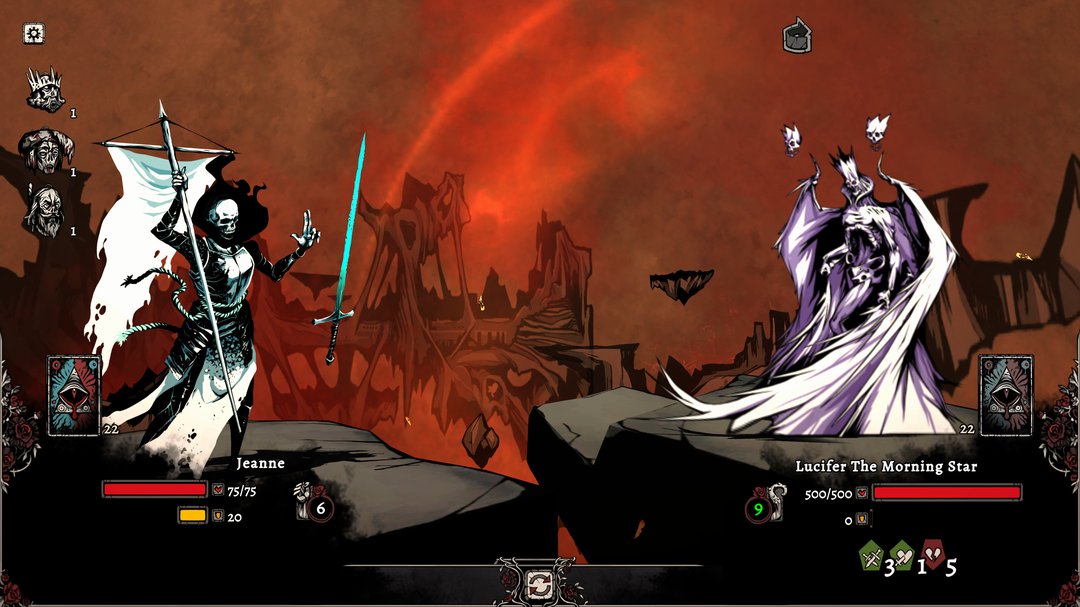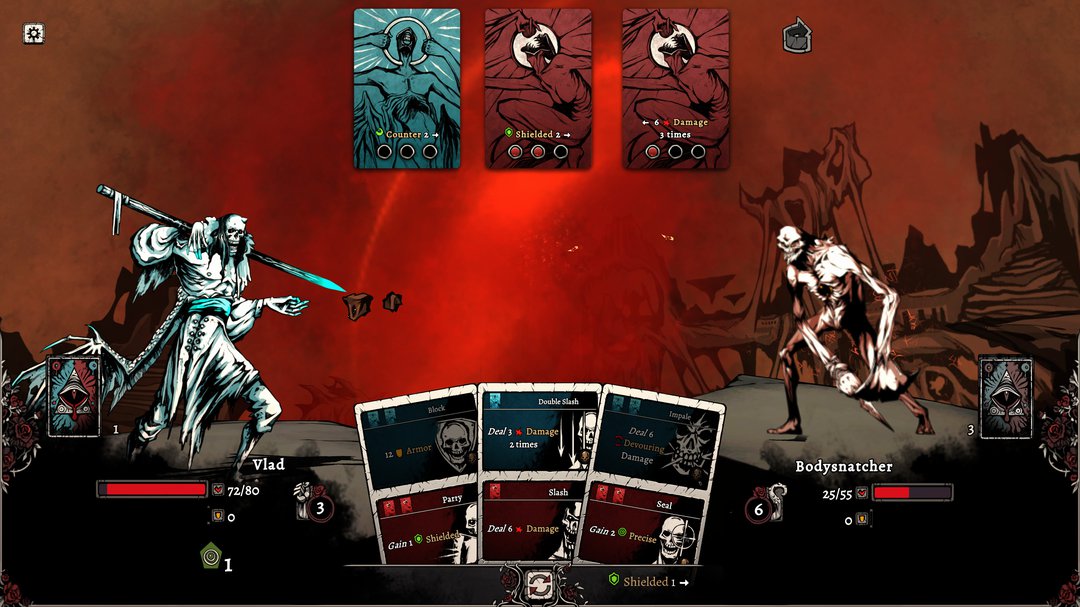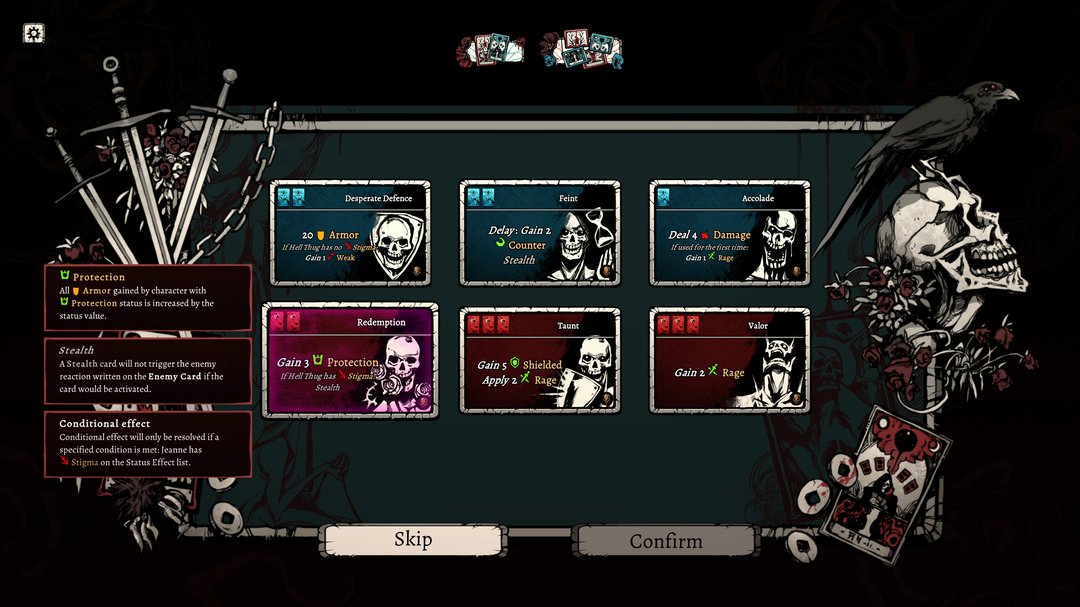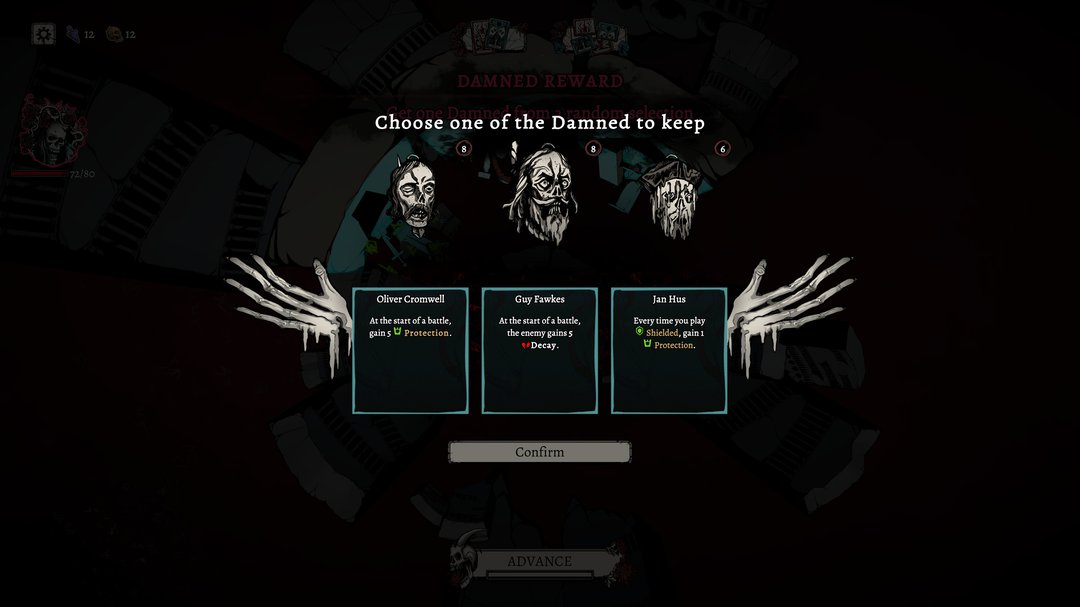The deck-building genre has exploded in popularity in recent years, starting with Slay the Spire and continuing with new favorites like Monster Train and Across the Obelisk. Honestly, the market is flooded, and is' easy for new titles to drown in a sea of similar concepts. Yet, when Nadir showed up in my game suggestions, it immediately caught my attention. The hellish visual style and the combat system felt captivating and unique, with a free demo enough to get me to buy in.
Nadir came out of early access this past February, and I was excited to see what new and delightfully twisted threats I had to face in my descent into Hell. I’m happy to say I was not disappointed, but the question for many gamers is whether this game is just pretty, or if it has more differences under the hood to make it stand out.
Climbing the Tower to Dive into the Abyss

It feels so cool being able to have the Light of France fighting the Light-Bringer. Even in death, she can’t be stopped!
Nadir sees you playing one of three damned souls in Hell, marching deeper into its depths to fight the embodiments of sins to conquer the realm. Anyone who’s played Slay the Spire will immediately notice some of its influences; many buffs and debuffs in Nadir work similarly. You’ll also feel right at home with the characters provided. Jeanne d’Arc (It was a clerical error!) is your hard and heavy hitter who can take some debuffs to gain strength, like the Ironclad. Vlad the Impaler fits the Silent’s niche with the addition of a little life drain, and Hernan Cortés wraith summoning will remind players of the orb combat style of the Defect.
Thankfully, that’s about where the similarities end, as Nadir tackles new territory with its battle system, offering a huge game changer to how deck building combat usually works. Of course, you have a starter deck of cards that grows and evolves as you play, and you use those cards to attack your enemy in various ways. But your enemy isn’t attacking you after each card you play, and is instead counter attacking based on your own actions.
This counter-play system works because of a red-blue color system baked into the cards and enemy abilities. Each card has two different abilities, one for each color. Think Split Cards in MTG and you get the idea. Each enemy also has three attack options, each one coded to red or blue. Whenever you play a card, you charge an enemy ability of the same color once. Once the ability has enough charges, the enemy performs their attack and then flips their ability over to a different one of the opposite color. What’s more, your cards have costs that dictate whether they need to charge one, two, or all three enemy’s abilities in order to be played.

It's a little hard to understand without visuals. See how the red enemy card with “Shielded 2” on it has 2/3 red dots filled? If I play Slash on that card, it will give the Bodysnatcher "2 Shielded" and then turn over to a blue ability. Playing cards without care will have your foe hitting back hard.
So instead of worrying about what attacks might come next every turn, you choose what you’re getting hit with and when, which feels strange to have some control over. Your enemy will always have the same six abilities, and you can check what they are at any time during battle. If you don’t like what’s in your hand, you can always choose to redraw, which gives you a brand new hand and flips all your enemies abilities over. They do keep their charges, though, so eventually you’ll have to face those threats instead. All these options provide a huge layer of depth and strategy that makes combat feel almost like a puzzle to be solved. It feels rich and satisfying to play, and you feel rewarded for memorizing enemy layouts and figuring out the best way to skirt their abilities, decide when damage is acceptable, and vanquish your foes.
The Road to Hell is Paved with Good Investments
Let’s get into thick of what you do outside of combat. After a battle, you’re given various currencies and the chance to craft a card. Your new card will always have a blue and a red ability, and you get to choose from 3 of each color. This gives you much greater control over what you’re putting in your deck, but it’s important to keep your costs balanced. Little hard to fight when your hand is full of three-costs, and your opponent has 2 blues and a red.

Cards don’t have to have the same cost (eg, 2 blue/2red), so consider that when choosing the best cards to fit your deck!
Your map is divided into several ring-like nodes, each having at least one battle encounter on it. In order to proceed to the next level, you have to complete at least one battle, but after that, the rest of the node is yours to take advantage of. Other options (eventually) let you buy abilities, power up your character, get static benefits called the Damned Rewards, customize your deck, and of course take a rest. When you advance to the next node, you also gain back a little HP for your troubles. What you get on each node is randomized on each run, so you have to be careful of what resources are available to you.
Each run is dictated by one of five sins, which influence the frequency of enemy types and the boss you face at the end. Once you face the boss sin, you’re free to end the run, but you also have the option to continue it. If you do, you enter new game + run, and enemies get harder to beat. If you built your deck well, it can be easy to blast through a second run for additional rewards if you want to. You may even find new combinations of powers you haven’t seen before, so it can be worth it to go again. I personally just like the power trip of blasting through once arduous foes and seeing how many I can kill without taking any health damage, but that’s just me.
We Built This City on Brimstone and Souls
Oh boy, now we get to the actual namesake of the game. Between each run, you’ll come back to the titular city of Nadir, a crumbling monolithic place floating in the realms of Hell. Here is where you can spend most of your currency to unlock additional stuff, including more options on nodes, new sins to encounter, new characters and more cards to go with them. Each addition builds new structures or modifies existing ones, so you get to see your progress in a more visual way, which I appreciated.

Don't worry about going it alone - Hell is full of familiar faces to help you try and get ahead!
Which brings me to the visual style. Everything in this game oozes with malicious and hellish atmosphere. All your enemies are love-children between Chronenberg monstrosities and demonic archetypes. The character you play is a skeleton with ragged clothes and wisps of a soul in their eye sockets; a shell of their former selves, but now unshackled by mortality and flesh. You’ll fight classic demons, such as Abaddon, Beelzebub, and Asmodeus, and eventually Lucifer himself! Everything was lovingly crafted to feel raw, gritty, and uncomfortable, ensuring you have a good time in a bad place.
Not that there isn’t some issues in there, though.
It is Hell, After All
While this game is fun to play, there are some growing pains that need to be addressed and patched. There is some animation lag when abilities are used, especially when Wraiths are involved. An enemy or two are missing animations when they’re hurt, making the opponent blip out for a bit, and it’s difficult to cancel out of a card once you’ve clicked it in battle. You technically have full view of the map when you play, but with how tiny the details can be, it would be nice to be able to look through the nodes to better understand what options you have available.
Now, this may just be me and I’ll admit that I’m not great at roguelikes, but it does feel like there are some balancing issues, especially concerning Hernan Cortez. Since any run you do is dictated by the Sin you chose to fight, some characters feel like they fair much worse than others against certain sins. I definitely struggle using Jeanne when doing a Wrath run, and Vlad faces a difficult early game in a Heresy run. Hernan faces the near opposite problem, because his damaging Wraiths don’t trigger enemy buffs and debuffs, making it really easy to turtle your way through with him, especially in a Gluttony and Greed run. If this is part of the strategy of the game, then it works! It feels great finding the character and playstyle that works best to complete your run. For me though, I would prefer if there was more balance between the characters so they were all viable choices on any given run.
All in all, this is a game with a great unique feel and fantastic art style, but it really does need another pass of polish to smooth out the rough edges.

I appreciate that you’re able to customize your character on each run to fit your current strategy. Do you get more Domination to control more static buffs? Get new card pieces?
Love the Sin, Love the Sinner
Despite these gripes, Nadir stands out as a great addition to the many roguelike deck builders currently out there. It’s battle system and atmosphere are more than enough to warrant giving this game a try. You can tell it just got out of early access, but there was a lot of passion put into this and it shows.
If you loved Slay the Spire or Monster Train, this may be a bit of an easier experience for you, but worth the novelty tit brings to the table! I would even recommend this to players trying out roguelikes and deck builders for the first time, given the ability to check enemy attacks anytime you want. While I’m not a fan of the character balancing, it does encourage trying new characters and teaching newer players to look outside their comfort zone. Regardless if you are a new player of this genre or an old hand, there's something unique here to enjoy. Even if it isn't perfect, Hell will welcome you happily.
Whether you want it to or not.